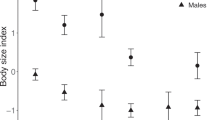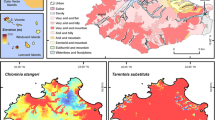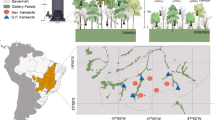Abstract
Tenebrionidae are one of the largest families of beetles and are known for their adaptations to hot and dry climates. An increase in body size also increases the volume/surface area ratio, which reduces transpiration, and hence water loss. If an increase in body size is an important adaptation in tenebrionids to cope with increasing aridity, we expect a correlation between body size and climatic gradients in the major tenebrionid clades. Alternatively, we can postulate that arid climates do not drive body size evolution, but rather select, from a wider fauna containing species of any size, those that have larger bodies. In this case we expect that drier regions will host faunas that contain, on average, larger species. To test the first hypothesis, we correlated inter-specific body size variation in the main tenebrionid clades with climatic gradients in Europe. We found only weak trends. To test the second hypothesis, we regressed mean body size of European country faunas against climatic characteristics. We found a strong increase in body size in southern faunas experiencing hot and dry climates. Therefore, increase in body size is not a major adaptation in tenebrionid evolution, but climate is an important filtering factor that determines a prevalence of larger species in southern Europe.

Similar content being viewed by others
References
Aalbu, R. L., Triplehorn, C. A., Campbell, J. M., Brown, K. W., Somerby, R. A., & Thomas, D. B. (2002). Family 106. Tenebrionidae Latreille 1802. In R. H. Arnett Jr., M. C. Thomas, P. E. Skelley, & J. H. Frank (Eds.), American Beetles. Volume 2. Polyphaga: Scarabaeoidea through Curculionoidea (pp. 463–509). Boca Raton: CRC.
Baselga, A. (2008). Determinants of species richness, endemism and turnover in European longhorn beetles. Ecography, 31, 263–271.
Cabrero-Sañudo, F. J. (2012). Composition and distribution patterns of species at a global biogeographic region scale: Biogeography of Aphodiini dung beetles (Coleoptera, Scarabaeidae) based on species geographic and taxonomic data. In L. Stevens (Ed.), Global advances in biogeography (pp. 329–360). Rijeka: InTech.
Chown, S. L. (1993). Desiccation resistance in six sub-Antarctic weevils (Coleoptera: Curculionidae): humidity as an abiotic factor influencing assemblage structure. Functional Ecology, 7, 318–325.
Condamine, F. L., Soldati, L., Rasplus, J.-Y., & Kergoat, G. J. (2011). New insights on systematics and phylogenetics of Mediterranean Blaps species (Coleoptera: Tenebrionidae: Blaptini), assessed through morphology and dense taxon sampling. Systematic Entomology, 36, 340–361.
Cope, E. D. (1887). The origin of the fittest: essays on evolution. New York: Appleton.
Davis, A. L. V., Scholtz, C. H., & Philips, T. K. (2002). Historical biogeography of scarabaeine dung beetles. Journal of Biogeography, 29, 1217–1256.
De Los Santos, A., Gómez-González, L. A., Alonso, C., Arbelo, C. D., & De Nicolás, J. P. (2000). Adaptive trends of darkling beetles (Col. Tenebrionidae) on environmental gradients on the island of Tenerife (Canary Islands). Journal of Arid Environments, 45, 85–98.
Devictor, V., van Swaay, C., Brereton, T., Brotons, L., Chamberlain, D., Heliölä, J., et al. (2012). Differences in the climatic debts of birds and butterflies at a continental scale. Nature Climate Change, 2, 121–124.
Digby, P. S. B. (1955). Factors affecting the temperature excess of insects in sunshine. Journal of Experimental Biology, 32, 279–298.
Doyen, J. T. (1993). Cladistic relationships among Pimeliine Tenebrionidae (Coleoptera). Journal of the New York Entomological Society, 101, 443–514.
Doyen, J. T., & Rogers, E. (1984). Environmental determinants of size variation in Eusattus muricatus (Coleoptera: Tenebrionidae). Journal of the Kansas Entomological Society, 57(3), 483–489.
Doyen, J. T., & Tschinkel, W. R. (1982). Phenetic and cladistic relationships among tenebrionid beetles (Coleoptera). Systematic Entomology, 7, 127–183.
Entling, W., Schmidt-Entling, M. H., Bacher, S., Brandl, R., & Nentwig, W. (2010). Body size - climate relationships of European spiders. Journal of Biogeography, 37, 477–485.
Fattorini, S. (2000). Dispersal, vicariance and refuges in the Anatolian Pimeliinae (Coleoptera, Tenebrionidae): remarks on some biogeographical tenets. Biogeographia, 21, 355–398.
Fattorini, S. (2008). Ecology and conservation of tenebrionid beetles in Mediterranean coastal areas. In S. Fattorini (Ed.), Insect ecology and conservation (pp. 165–297). Trivandrum: Research Signpost.
Fattorini, S., & Baselga, A. (2012). Species richness and turnover patterns in European tenebrionid beetles. Insect Conservation and Diversity, 5, 331–345.
Fattorini, S., & Ulrich, W. (2012a). Drivers of species richness in European Tenebrionidae (Coleoptera). Acta Oecologica, 43, 22–28.
Fattorini, S., & Ulrich, W. (2012b). Spatial distributions of European Tenebrionidae point to multiple postglacial colonization trajectories. Biological Journal of the Linnean Society, London, 105, 318–329.
Fattorini, S., Sciotti, A., Tratzi, P., & Di Giulio, A. (2013a). Species distribution, ecology, abundance, body size and phylogeny originate interrelated rarity patterns at regional scale. Journal of Zoological Systematics and Evolutionary Research, 51, 279–286.
Fattorini, S., Lo Monaco, R., Di Giulio, A., & Ulrich, W. (2013b). Latitudinal trends in body length distributions of European darkling beetles (Tenebrionidae). Acta Oecologica, 53, 88–94.
Felsenstein, J. (1985). Phylogenies and the comparative method. American Naturalist, 125, 1–15.
Ferrer, J. (2008). Contribución al conocimiento de los Asinini iberobaleares. Segunda nota. Las Alphasida (Glabrasida) del grupo Tricostatae Escalera 1922 (Coleoptera, Tenebrionidae, Pimeliinae). Boletín Sociedad Entomológica Aragonesa, 43, 61–73.
Ferrer, J. (2011). Contribución al conocimiento del Género Phylan dejean, 1821, y descripción de una especie nueva del género Heliopates Dejean, 1834 (Coleoptera, Tenebrionidae, Pedinini). Boletín Sociedad Entomológica Aragonesa, 49, 75–82.
Hadley, N. F. (1994). Water relations of terrestrial arthropods. San Diego: Academic Press.
Homburg, K., Schuldt, A., Drees, C., & Assmann, T. (2012). Broad-scale geographic patterns in body size and hind wing development of western Palaearctic carabid beetles (Coleoptera: Carabidae). Ecography, 36, 166–177.
Knouft, J. H. (2004). Latitudinal variation in the shape of the species body size distribution: an analysis using freshwater fishes. Qecologia, 139, 408–417.
Köhler, F. (1996) Zur Käferfauna (Col.) des Korretsberges und des Michelberges im Mittelrheintal. Mitteilungen der Arbeitsgemeinschaft Rheinischer Koleopterologen (Bonn) 6, 3–36.
Krasnov, B., Ward, D., & Shenbrot, G. (1996). Body size and leg length variation in several species of darkling beetles (Coleoptera: Tenebrionidae) along a rainfall and altitudinal gradient in the Negev Desert (Israel). Journal of Arid Environments, 34, 477–489.
Levkaničová, Z. (2009). Molecular phylogeny of the superfamily Tenebrionoidea (Coleoptera: Cucujiformia). Ph.D. Thesis. Olomouc: Faculty of Science, Department of Zoology and Anthropology, Palacký University.
Löbl, I., & Smetana, A. (2008). Catalogue of palaearctic coleoptera. Volume 5. Tenebrionoidea. Stenstrup: Apollo Books.
Lomolino, M. V., Riddle, B. R., Whittaker, R. J., & Brown, J. H. (2010). Biogeography (Forthth ed.). Sunderland: Sinauer.
Marcuzzi, G. (1960). Rapporti tra equilibrio idrico e ambiente nei Coleotteri Tenebrionidi. Archivio Zoologico Italiano, 45, 325–342.
Meiri, S., Dayan, T., & Simberloff, D. (2005). Biogeographical patterns in the Western Palearctic: the fasting-endurance hypothesis and the status of Murphy’s rule. Journal of Biogeography, 32, 369–375.
Murphy, E. L. (1985). Bergmann’s rule, seasonality and geographic variation in body size of house sparrows. Evolution, 39, 1327–1334.
Olson, V. A., Davies, R. G., Orme, C. D. L., Thomas, G. H., Meiri, S., Blackburn, T. M., et al. (2009). Global biogeography and ecology of body size in birds. Ecology Letters, 12, 249–259.
Peat, J., Darvill, B., Ellis, J., & Goulson, D. (2005). Effects of climate on intra- and interspecific size variation in bumble bees. Functional Ecology, 19, 145–151.
Penev, L. (1996). Large-scale variation in carabid assemblages, with special reference to the local fauna concept. Annales Zoologici Fennici, 33, 49–63.
Pons, J., Bruvo, B., Petitpierre, E., Plohl, M., Ugarkovic, D., & Juan, C. (2004). Complex structural features of satellite DNA sequences in the genus Pimelia (Coleoptera: Tenebrionidae): random differential amplification from a common ‘satellite DNA library’. Heredity, 92, 418–427.
Rangel, T.F.L., Diniz-Filho, J.A.F., Bini, L.M. (2010). SAM: a comprehensive application for Spatial Analysis in Macroecology Ecography, 33, 46–50.
Ryder, O. A. (1986). Species conservation and systematics: the dilemma of subspecies. Trends in Ecology and Evolution, 1, 9–10.
Soldati, F., & Soldati, L. (2006). Species delimitation using morphological and molecular tools in the Asida (Polasida) jurinei Solier, 1836 species-complex. Preliminary results. (Coleoptera: Tenebrionidae: Tentyrinae). Cahiers Scientifiques Muséum Lyon, 10, 111–116.
Speight, M. R., Hunter, M. D., & Watt, A. D. (2008). Ecology of insects (2nd ed.). Oxford: Wiley-Blackwell.
Stevenson, R. D. (1985). Body size and limits to the daily range of body temperature in terrestrial ectotherms. American Naturalist, 125, 102–117.
Stroscio, S., Baviera, C., Frati, F., Lo Paro, G., & Nardi, F. (2011). Deep genetic divergence in the darkling beetle Pimelia rugulosa (Coleoptera, Tenebrionidae) reflects Plio-Pleistocenic paleogeographic history of Sicily. Journal of Zoological Systmatics and Evolutionary Research, 49, 196–203.
Trichas, A. (2008). The genus Dendarus Latreille, 1829 (Coleoptera, Tenebrionidae: Dendarini) in Greece (A systematic account of the genus with description of a new species and four new systematic combinations). In: S. E. Makarov, Dimitrijević, R. N. (Eds.), Advances in arachnology and developmental biology (pp. 417–462). Belgrade: SASA, Belgrade & UNESCO MAB Serbia.
Ulrich, W., & Fiera, C. (2010). Environmental correlates of body size distributions of European springtails (Hexapoda: Collembola). Global Ecology and Biogeography, 19, 905–915.
Acknowledgments
We are particularly grateful to M. Lillig for his invaluable help in finding many references reporting body length measures. We thank the following people for providing unpublished faunal data and/or for checking regional faunal lists used in this study: O. R. Alexandrovitch (Belarus), B. Gustafsson (Denmark, Norway, Finland, Sweden), P. Leo (France, Italy, Greece, Spain, overall distribution of many species and comments about completeness of inventories), and F. Soldati (France, Italy, Romania, Greece), who also provided some body length measures. We are very grateful to two anonymous referees for their constructive comments. H. Pearson kindly improved our English.
Conflict of interest
The authors declare that they have no conflict of interest.
Author information
Authors and Affiliations
Corresponding author
Electronic supplementary material
Below is the link to the electronic supplementary material.
Online Resource 1
(DOC 73 kb)
Online Resource 2
(DOC 107 kb)
Rights and permissions
About this article
Cite this article
Fattorini, S., Lo Monaco, R., Di Giulio, A. et al. Climatic correlates of body size in European tenebrionid beetles (Coleoptera: Tenebrionidae). Org Divers Evol 14, 215–224 (2014). https://doi.org/10.1007/s13127-013-0164-0
Received:
Accepted:
Published:
Issue Date:
DOI: https://doi.org/10.1007/s13127-013-0164-0




